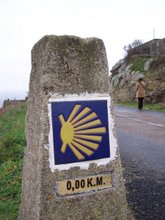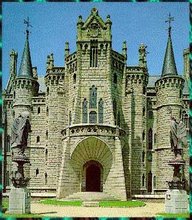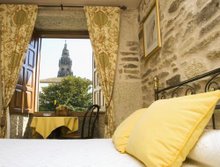Sunday, June 3, 2007
21 km today
Finally, the crunch of the Camino under my boots. Flowers release their scent into the cool of the morning. Across the fields, you can see the red roofs and church tower of a small town.
It´s hard to sleep late at an albergue. This morning people were up at 5:30 am, packing their bags and calling out in a stage whisper, "Nieves! Donde estas?!" Breakfast wasn´t until 6:30, but I got up anyway and talked for a while to the hostelero, a Scottish man named Skye was was volunteering to run this rather large establishment. He told me about his favorite albergues along the road, and said he´d walked the Camino de Plata (which comes from the south) in the heat of midsummer.
What did you wear? I asked
Very little, he said.
I left around 7:30 -- everyone has to be out by 8 am, and then they open again in the afternoon,usually around 2 pm. A little woman walking with two big poles was passing as I came out of the hostal and together we found our way out of Astorga. There are usually yellow arrows or scallop shell signs but occasional it´s hard to tell which way to go.
There were a dozen and a half pilgrims leaving town at about the same time, and for a the first 30 minutes, we were all sort of clumped together. Then we each found our own rhythm (some singles, some in groups), and became strung out along the trail. At first the Camino paralleled the road and even at points coincided with it (cars sped by), but at Murias de Rechivaldo, it struck out across open fields and I breathed a sigh of relief.
Lots of wildflowers in bloom, and a sound like crickets. At El Ganso (The Goose), an old man rang the church bell, and on one side of the church tower was an enormous stork´s nest. A small group of middle-aged and older villagers were clustered around the chuch door. Far from exhibiting the dour-faced suspicion of many small-towners, these people were amazingingly friendly, giving us bundles of hierba buena and inviting us in to see their church. One man asked me where I was from, then started spouting very plausible statistics about how much of California was Hispanic. I guess there´s still pride, however far removed, whenever the Spanish culture and language makes inroads.
I lit two candles in the church and it was immediately clear who I was lighting them for, though I hadn´t been thinking conciously of those two people.
The walking came easily and it didn´t feel like work until about the 18th km, when the last 3 km to Rabanal de Camino pitched upwards and my feet started to let me know it was time to stop.
Rabanal de Camino, with 35 full-time residents and a mediavel look, is at 1150 meters (Astorga is at 873), so the whole day was a gradual climb, with the last part being less gradual. Tomorrow I´ll hit the highest point on my Camino--just after Manjarin, at 1517 meters. Arrived in Rabanal around noon, so that´s about 4 hours to walk around 20 km.
There ARE a lot of people walking, but it seems ok. Most pilgrims you encounter smile and say Buen Camino. A few times I fell into step with another pilgrim and we talked for a while--where are you from, why are you walking. You´re spilling intimate details of your life before you know the other person´s name. But then you slow down or speed up and the conversation is over, for now at least. It´s like currents in a river that coincide briefly and then veer off into parallel but separate streams.
Midday Mass
I found an albergue, dumped my pack at the closed front door (lots of pilgrims hanging out--I asked someone to watch my stuff), exchanged my boots for tennies, then went down the street to 12:30 mass, sung by 3 Benedictine brothers. The church was narrow and tall and cold, with a lavish gold leaf altar. Saints wore multi-colored robes, cherubs played guitars, and pillars were festooned with golden vines and cherub faces like giant flowers. No crucifix here--pride of place went to San Jose holding his child (Jesus). At the top of the altar was a gold scallop shell, symbol of Santiago.
I´d seen the 3 brothers come down the cobblestone street from their monastery to the church. They smiled at everyone, local and pilgrim alike, and one of them, who turned out to be the priest, gamely posed for a photo with an insistent pilgrim who treated the holy man as if he were a Disney character.
A dozen people filed into the church and waited quietly for the mass to begin. Most were older locals, but there were also a few pilgrims (to my shame, one took a flash photo during the mass). It was cold in the church and so quiet that swallowing seemed like a sacrilege. But when the Benedictines started in with the Gregorian chants, the whole place warmed up. After the chants and some call and response, there was a sermon about the mystery of the Holy Trinity (the festival of Corpus Christi is on June 6). The priest used the elaborate altarpiece as a teaching tool, pointing out representations of God the Father, the baby Jesus, and a dove, symbolizing the Holy Trinity.
Que seamos uno, he kept saying, which I thought was beautiful and inclusive--not "They are one" but "That we should all be one."
At some point during the mass, the tears started. I wasn´t thinking of anything sad and in fact I wasn´t really thinking at all. But the tears wouldn´t stop. I got tired of wiping them away and just let them run down my face. I felt embarrassed, but I didn´t know anyone there, and I told myself, Emotion is not the enemy. I´m not even sure what that means, but at that moment it felt like I couldn´t fight my very emotional response, even though I didn´t know what I was crying about. It felt a little like suddenly, in that cold church, warmed by chants written centuries ago, the world seemed impossibly old and sad and beautiful. And I was letting all that was old and sad and beautiful come through me and pour out of my eyes.
After the mass, the priest started talking about mundane parish business--the renovations of the Romanesque church up the street, the upcoming festivities--how fireworks were expensive, and the insurance for the fireworks even more expensive--which gave me time to recover and come back to myself. But as I emerged into the midday sun I felt that the mass had been harder on me than the 20-km walk.
Oh, one more thing. During the mass, when the priest brought out the tray with the challice and the little dish of hosts (tostones in Spanish, which always makes me think of toast), I got scared. I like going to mass now and then, especially in foreign countries. But when communion--the whole body-and-blood thing--looms, I always have to decide, Will I do it? Will I go all the way? I almost always answer no. I mean, who am I to partake of such a ritual, being essentially a non-beleiver? But today I said yes. Let´s do it. Let´s go all the way. So I did. Or rather, we did. Que seamos uno.
Fellow pilgrims of the day
Patricia, Australian world traveler now based in London. 70ish, with a beautiful, bony, somewhat ravaged face and bright blue eyes. Between Burgos and Leon, she tripped and fell on her face and arm. Her face was bleeding profusely and her arm didn´t feel quite right. She walked 6 km to the next town, where they cleaned her up and told her her arm was probably broken. They drove her to Leon where doctors applied a plaster cast and told her to return in a week for a checkup.
But I´m walking the Camino, she protested. Well, they said, you´re going to have to stop. But Patrica insisted that she would not, and they finally told her that she could get her checkup at Ponferrada, about seven day´s walk from Leon. And she´s walking, with a cast on her arm and big blue bruises on her face. She did make one concession--she´s not carrying her pack. She has it drivern ahead to her next stop.
As she told this story in the hostel, we all listened, rapt. One guy said the nuns in Leon were already telling her story. Another woman said to Patrica, "Now clear this up for me. Today I was walking, and I was really making time. I passed you, a woman with a broken arm and bruises on her face. And then, ten minutes later, I passed you again. Now did you get a ride or what?"
Patrica hadn´t gotten a ride, and no one could offer up a possible explantion for this other woman passing her, it seemed, twice. We joked about being at ground zero of the making of a saint.
In the future, I said, pilgrims will break their own arms just to follow in your footsteps.
We´ll build a shrine at the exact place where you fell, said someone else.
The broken-armed saint, said a guy perched on an upper bunk.
We were all kidding, sort of.
Daniel, 38, from Amsterdam, taking a 1-year leave of absence from his job as head of international marketing and acquisitions for a paint company. A year ago his girlfreind, a famous actress in Holland, died of cancer. Daniel went into a tailspin, and decide to walk the camino to work through his grief and see what came next.
"I ask people if they´re having a good walk," he told me. "And a lot of them say no. I ask why, and they say it´s the race for beds. They feel they have to get up early and race their 20 or 25 km, to get to the next place by noon or early afternoon: They stand in line until the hostal opens and then grab their bunk. It makes people so anxious."
His advice to me was to let go of the bed race. "There will always be a place for you, somewhere. And if you walk in the afternoon, you´ll find there´s hardly anyone on the Camino."
A woman from Quebec, recently retired from working at the national auditing office. She was the first pilgrim I saw this morning, the small woman walking with two big poles (a lot of pole walking on the trail, and yes, a lot of convertible pants).
She had a yoga pad strapped to the outside of her pack. Since retiring she´d been doing three hours of yoga a day. On the Camino, she said it was a necessary corrective to walking so much.
We talked about how we felt we weren´t walking for just ourselves. I told her I´d offered to carry prayers and objects for family and friends. She´d done something similar, but with a twist. She´s asked people to write a prayer or plea or problem on a slip of paper and seal it in an envelope. Each morning on the camino she opened one of the envelopes, and walked that day carrying whatever she´d read on the slip of paper.
Tuesday, June 5, 2007
Subscribe to:
Post Comments (Atom)





4 comments:
This is absolutely great! I feel like I'm walking right along with you but having trouble keeping up. Love you.
Beautiful post. Absolutely delightful.
I was here that day, I walked with patricia for a few days previous. Its great to read someone elses experience and see people/times that I saw :)
Post a Comment